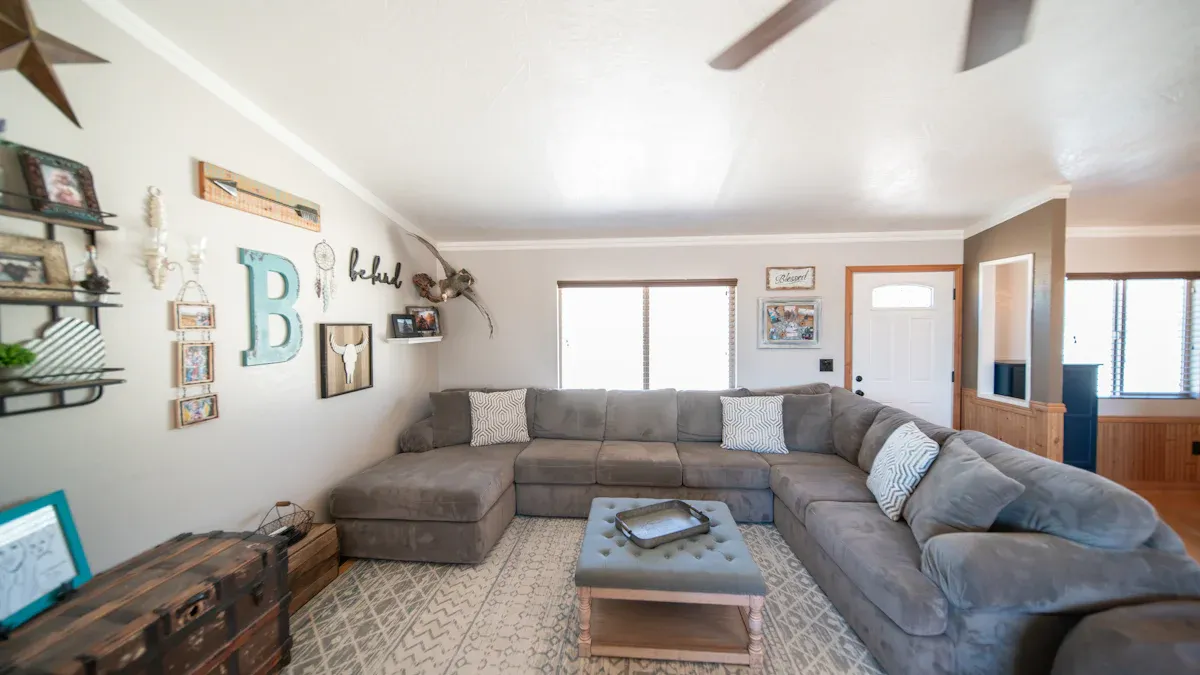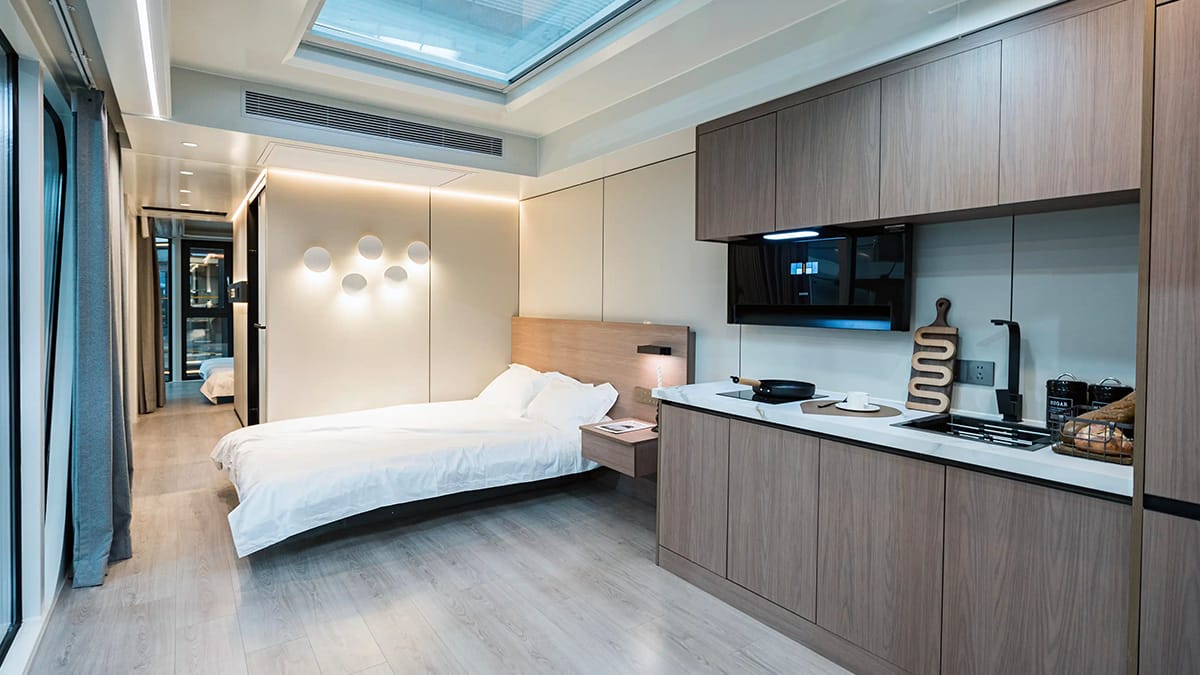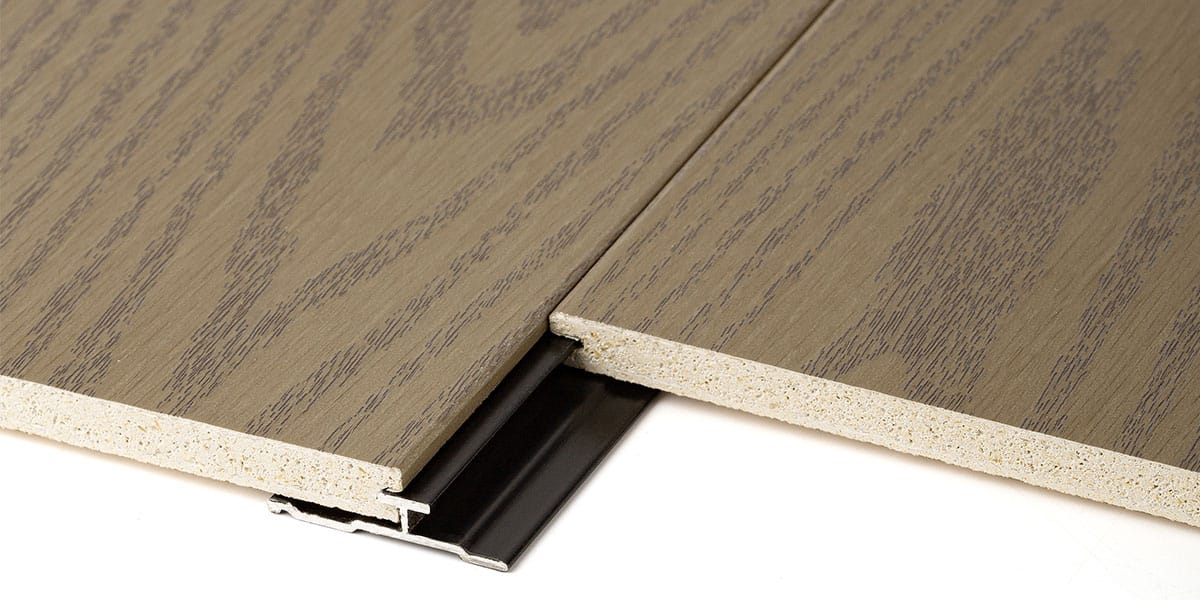
13 Sep Tips for Choosing Magnesium Wall Board in Mobile Homes
Table of Contents
Looking for the best wall board for your mobile homes? Focus on durability and moisture resistance first. Many panels exist—wood, vinyl, or drywall—but magnesium wall board stands out. It handles moisture, resists damage, and lasts longer. You want walls that stay strong and look good every day.
Key Takeaways
Magnesium wall board stops fire and water well. This makes it a great pick for mobile homes.
If you install and care for magnesium wall board right, it lasts longer. Your walls will stay strong for many years.
Magnesium wall board may cost more at first. But it lasts a long time and keeps your home safe. This makes it a good choice for you.
Magnesium Wall Board Basics
What Is It?
Magnesium wall board is a modern building material that gives you strong, safe walls. You might wonder how it’s made. Here’s a simple look at the process:
Workers gather magnesium oxide powder, magnesium salts, perlite, wood fiber, and water.
They mix these dry and wet ingredients until smooth.
The mixture gets poured into molds, and fabric layers are added for extra strength.
The molds are pressed to make the boards dense and tough.
The boards cure in special rooms to finish the process.
This careful process creates a wall board that stands up to daily life in mobile homes.
Why Choose for Mobile Homes
You want your walls to last, look good, and keep your home safe. Magnesium wall board checks all those boxes. Take a look at what makes it special:
Description | |
|---|---|
Fire Resistance | Protects your home from fire and impact. |
Moisture Resistance | Stays strong even in damp places. No mold or mildew, unlike regular drywall. |
Durability | Handles bumps, scratches, and even insects. Great for busy spaces. |
Dimensional Stability | Does not warp or change shape when the weather changes. |
Environmental Considerations | Made from natural materials. Safe for your family and the planet. Recyclable, too. |
Tip: Experts recommend magnesium wall board for mobile homes because it resists fire and water, and it’s better for the environment than many other options.
Choosing Wall Panels for Mobile Homes
 When you pick wall panels for mobile homes, you have lots of choices. Each material has its own strengths and weaknesses. Let’s break down what you need to know before you decide.
When you pick wall panels for mobile homes, you have lots of choices. Each material has its own strengths and weaknesses. Let’s break down what you need to know before you decide.
Durability & Moisture Resistance
You want walls that last and stay dry. In mobile homes, moisture can sneak in, especially in kitchens and bathrooms. Some panels handle water better than others:
Vinyl Over Gypsum (VOG): You often see these in kitchens and bathrooms. They resist water and clean up easily.
Paper-Faced Drywall: Good for painting or wallpapering, but not great with moisture.
Magnesium Wall Board: Stands out for water resistance. It fights mold and mildew, so it works well in damp places.
Plywood and Wood Paneling: Looks natural and feels sturdy, but needs care to avoid water damage.
Composite Materials: Modern panels that resist water and stay lightweight.
Magnesium wall board does a great job in wet areas. It keeps mold away and stays strong. If you live in a humid climate, you might see some surface moisture, but it still protects better than regular drywall.
Fire Safety
Safety matters in mobile homes. You want panels that help keep your family safe if a fire starts. Here’s how some common materials compare:
Material | Fire Rating | Extra Notes |
|---|---|---|
Magnesium Wall Board | Won’t burn or make harmful smoke. | |
Traditional Drywall | Class B | Lower fire resistance than magnesium boards. |
Plywood | Class C | Burns faster and makes more smoke. |
Magnesium wall board is certified for fire safety. It even releases water vapor during a fire, which helps slow down flames. You get peace of mind knowing your walls add extra protection.
Weight & Installation
You want panels that are easy to handle and install. Heavy panels can be tough in mobile homes. Here’s a quick look at how some materials stack up:
Material | Weight (per square foot) |
|---|---|
12mm MagPanel | 2.2 pounds |
Gypsum Board | Lighter than MagPanel |
Cement Board | Heavier than MagPanel |
Magnesium wall board is not the lightest, but you can still install it without much trouble. It’s easier than cement board and strong enough for daily use.
Cost & Budget
Budget is important when you fix or upgrade your mobile home. Some panels cost more than others. Here’s a simple comparison:
Material | Average Cost per Square Foot |
|---|---|
MgO Boards | |
Regular Gypsum Boards | $0.50 – $1.00 |
Magnesium wall board costs more than regular drywall. You pay extra for fire safety and water resistance. If you want long-lasting walls, the investment can pay off.
Structure Compatibility
Not every wall panel fits every mobile home. You need to check your frame and make sure the panels work with your setup. Here’s what you should do:
Store magnesium wall board in a dry, ventilated spot. Keep it flat and away from moisture.
Let the board adjust indoors for three days before you install it. Make sure the room is warm enough.
Install the board after you finish any wet work, like painting or plastering.
Use the right fasteners. Check that your framing is straight and level.
Magnesium wall board works with many frame types. It’s strong and handles weather changes. You save time because you need fewer layers. You also get better insulation and strength when you pair it with composite panels.
Pros and Cons of Common Wall Panel Materials
Here’s a quick table to help you compare the most popular wall panels for mobile homes:
Material | Pros | Cons |
|---|---|---|
Wood Panels | Natural look, paintable, stainable | Needs care to avoid damage |
VOG Walls | Lightweight, easy to clean, water-resistant | Not very strong, seams show |
Paper-Faced Drywall | Customizable, good insulation | Poor water resistance |
Magnesium Wall Board | Fire-safe, water-resistant, strong | Quality can vary |
Composite Materials | Water-resistant, lightweight | Uneven quality sometimes |
Tip: Always match your wall panel choice to your needs. If you want safety and durability, magnesium wall board is a smart pick for mobile homes.
Magnesium vs. Other Panels
 Gypsum
Gypsum
You probably know gypsum board as drywall. People use it in many homes because it is cheap and easy to find. You can paint it or cover it with wallpaper. Gypsum board feels light, so you can carry it without much trouble. If you want to install it in mobile homes, you need to watch out for water. Gypsum does not like moisture. It can get soft and grow mold if you have leaks or high humidity.
Let’s look at how magnesium wall board compares to gypsum:
Feature | Magnesium Wall Board | Gypsum Board |
|---|---|---|
Water Resistance | Excellent | Poor |
Fire Safety | High | Moderate |
Durability | Strong | Can crack easily |
Mold Resistance | Yes | No |
Cost | Higher | Lower |
Note: If you want walls that last and stay dry, magnesium wall board beats gypsum every time.
Plywood
Plywood gives your walls a warm, wood look. You can stain it or paint it to match your style. Many people like plywood because it feels sturdy. You can hang shelves or pictures without much worry. Plywood works well in dry places. If you use it in mobile homes, you need to protect it from water. Plywood can swell, warp, or rot if it gets wet.
Here’s a quick list to help you compare:
Magnesium wall board resists water and fire.
Plywood needs sealing to fight moisture.
You can install both with basic tools.
Magnesium wall board does not attract insects.
Plywood can get termites or bugs.
If you want easy repairs, magnesium wall board lets you patch holes or cracks with simple filler. Plywood repairs take more work. You might need to replace whole panels if they get damaged.
Vinyl
Vinyl wall panels feel light and easy to clean. You see them in bathrooms and kitchens a lot. Vinyl does not mind water, so it works in damp spots. You can wipe it down with a cloth. Vinyl panels snap together fast. You do not need special skills to install them in mobile homes.
Let’s compare vinyl and magnesium wall board:
Feature | Magnesium Wall Board | Vinyl Panels |
|---|---|---|
Water Resistance | Excellent | Excellent |
Fire Safety | High | Low |
Durability | Strong | Can dent or scratch |
Appearance | Paintable | Limited styles |
Repair | Easy | Hard to patch |
Tip: If you want fire safety and a strong surface, magnesium wall board gives you more protection than vinyl.
Trusscore
Trusscore panels use PVC and fiberglass. They feel tough and resist water. You can install them quickly because they are light. Trusscore panels work well in garages, laundry rooms, and mobile homes. You do not need to paint them. They come in bright white and stay clean with a wipe.
Here’s a table to show the differences:
Feature | Magnesium Wall Board | Trusscore Panels |
|---|---|---|
Water Resistance | Excellent | Excellent |
Fire Safety | High | Moderate |
Weight | Moderate | Light |
Installation | Easy | Very easy |
Repair | Simple patch | Replace panel |
If you want to fix damage, magnesium wall board lets you use filler and paint. Trusscore panels need full replacement if you get a big crack.
Callout: Magnesium wall board gives you a strong, safe wall. You get fire protection, water resistance, and easy repairs. Other panels have their own strengths, but magnesium wall board stands out for safety and durability in mobile homes.
Installation Tips for Mobile Homes
Surface Prep
Getting your walls ready is the first step. You want a clean, flat surface so your new panels last longer. Here’s how you can prep for magnesium wall board:
Wipe away dirt, grease, and dust with a damp cloth. Let the wall dry.
Use a level to check for bumps or dips. Fill low spots or sand down high areas.
Measure your space and plan where each board will go. Leave a small gap between boards for expansion.
Tip: Careful prep makes the rest of your project much easier!
Cutting & Fitting
Cutting magnesium wall board is simple if you use the right tools. For big cuts, grab a circular saw with a thin carbide blade. For small cuts, score the board with a utility knife and snap it. Always wear safety glasses and a mask to keep dust away. Sand the edges if they feel rough. Make sure each piece fits snugly before you move on.
Fastening
You want your panels to stay put. Use 316-stainless steel or ceramic-coated fasteners for the best hold. If you have wood studs, #8 flat head screws work well. For metal framing, use self-drilling screws. Place fasteners at least 4 inches from corners, 6 inches apart around the edges, and 12 inches apart in the center.
Finishing
Leave a small gap (about 1/8 inch) between boards for expansion. Fill the gaps with a strong sealant, then press fiberglass tape into the seams. Cover with a finishing compound and sand lightly for a smooth look. You can use battens over seams for a classic mobile home style or to add a decorative touch.
Note: Keep the room at a steady temperature and humidity while you finish your walls.
Maintenance & Repairs
Cleaning
Keeping your magnesium wall board clean is easy. You can use a soft cloth or sponge with warm water. If you see stains, try a mild soap. Avoid harsh chemicals because they can damage the surface. For dust, a vacuum with a brush attachment works well. You don’t need special cleaners. Just wipe gently and let the wall dry. If you spill something, clean it up right away. This helps your walls stay fresh and bright.
Tip: Regular cleaning keeps your walls looking new and helps prevent mold or mildew.
Fixing Damage
Accidents happen. If you get a small scratch or dent, you can fix it yourself. Use a patching compound or filler made for magnesium board. Apply it with a putty knife and let it dry. Sand the area until it feels smooth. You can paint over the repair if you want. For bigger holes, cut out the damaged part and fit a new piece of board. Fasten it in place and finish with tape and compound. You don’t need to call a pro for most repairs.
Preventing Issues
You want your walls to last. Here are some simple steps to avoid moisture or structural problems:
Use air conditioners or dehumidifiers to keep humidity below 50%.
Clean up leaks or spills right away and fix leaks fast.
Turn on exhaust fans when you cook, bathe, or use the dishwasher.
Make sure your home has enough vents underneath for good airflow.
Check the vapor barrier under your home often and keep it in good shape.
Staying ahead of moisture and keeping your home ventilated helps your magnesium wall board stay strong for years.
You need walls that are strong and safe in your mobile home. Magnesium wall board helps protect against fire and water. It is also easy to fix if it gets damaged. Here are some tips you can try yourself: let the panels sit in your room before you put them up, place each panel in a different spot so seams do not line up, use stainless steel screws, and leave little spaces between the boards. Look at all your options and enjoy your new walls without stress!
FAQ
Can you paint magnesium wall board?
Yes, you can paint it. Use a primer first. Choose acrylic or latex paint for the best results. Your walls will look fresh and clean.
Is magnesium wall board safe for kids and pets?
You get a safe wall. Magnesium wall board does not release toxins. It resists mold and fire. Your family stays protected.
How do you fix a small hole in magnesium wall board?
Grab some patching compound. Fill the hole. Let it dry. Sand it smooth. You can paint over the spot. Quick and easy!

 Gypsum
Gypsum